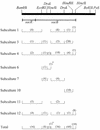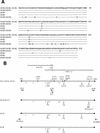Two amino acid residues of transposase contributing to differential transposability of IS1 elements in Escherichia coli
- PMID: 9748470
- PMCID: PMC107573
- DOI: 10.1128/JB.180.19.5279-5283.1998
Two amino acid residues of transposase contributing to differential transposability of IS1 elements in Escherichia coli
Abstract
Escherichia coli W3110 contains four types of IS1 elements in the chromosome. Using an insertion element entrapping system, we collected 116 IS1 plasmid insertion mutants, which resulted from a minimum of 26 independent IS1 insertion events. All of them had insertions of IS1 of the IS1A (IS1E and IS1G) type. Inspection of the transposase sequences of the four IS1 types and the IS1 of the resistance plasmid R100 showed that two amino acid residues, His-193 and Leu-217 of transposase, might contribute to differential transposability of IS1 elements in W3110. The two amino acid residues of the transposase in IS1A (IS1E and IS1G) were altered separately by site-directed mutagenesis, and each mutant was found to mediate transposition at a frequency about 30-fold lower than that of IS1A (IS1E and IS1G). Thus, the assumption that His-193 and Leu-217 of transposase contribute to differential transposability of IS1 elements in W3110 was confirmed.
Figures


Similar articles
-
The seventh copy of IS1 in Escherichia coli W3110 belongs to the IS1 A (IS1E) type which is the only IS1 type that transposes from chromosome to plasmids.Proc Natl Sci Counc Repub China B. 1997 Jul;21(3):100-5. Proc Natl Sci Counc Repub China B. 1997. PMID: 9309873
-
Presence of a characteristic D-D-E motif in IS1 transposase.J Bacteriol. 2002 Nov;184(22):6146-54. doi: 10.1128/JB.184.22.6146-6154.2002. J Bacteriol. 2002. PMID: 12399484 Free PMC article.
-
Four types of IS1 with differences in nucleotide sequence reside in the Escherichia coli K-12 chromosome.Gene. 1991 Feb 1;98(1):1-5. doi: 10.1016/0378-1119(91)90096-t. Gene. 1991. PMID: 1849492
-
Involvement of H-NS in transpositional recombination mediated by IS1.J Bacteriol. 2001 Apr;183(8):2476-84. doi: 10.1128/JB.183.8.2476-2484.2001. J Bacteriol. 2001. PMID: 11274106 Free PMC article.
-
IS1-encoded proteins, InsA and the InsA-B'-InsB transframe protein (transposase): functions deduced from their DNA-binding ability.Adv Biophys. 1995;31:209-22. doi: 10.1016/0065-227x(95)99393-4. Adv Biophys. 1995. PMID: 7625275 Review.
Cited by
-
IS-linked movement of a restriction-modification system.PLoS One. 2011 Jan 31;6(1):e16554. doi: 10.1371/journal.pone.0016554. PLoS One. 2011. PMID: 21305031 Free PMC article.
-
Characterization of insertions of IS476 and two newly identified insertion sequences, IS1478 and IS1479, in Xanthomonas campestris pv. campestris.J Bacteriol. 1999 Feb;181(4):1220-8. doi: 10.1128/JB.181.4.1220-1228.1999. J Bacteriol. 1999. PMID: 9973349 Free PMC article.
References
-
- Birkenbihl R P, Vielmetter W. Complete maps of IS1, IS2, IS3, IS4, IS5, IS30 and IS150 locations in Escherichia coli K12. Mol Gen Genet. 1989;220:147–153. - PubMed
-
- Boyer H W, Roulland-Dussoix D. A complementation analysis of the restriction and modification of DNA in Escherichia coli. J Mol Biol. 1969;41:459–472. - PubMed
-
- Chandler M, Galas D J. Cointegrate formation mediated by Tn9. II. Activity of IS1 is modulated by external DNA sequences. J Mol Biol. 1983;170:61–91. - PubMed
-
- Chen J-H, Porter R D. Characterization of the types of mutational events that spontaneously occur in a plasmid system. Mutat Res. 1988;197:23–37. - PubMed
-
- Chen J-H, Yeh H-T. The seventh copy of IS1 in Escherichia coli W3110 belongs to the IS1A (IS1E) type which is the only IS1 type that transposes from chromosome to plasmids. Proc Natl Sci Counc Repub China. 1997;21:100–105. - PubMed
MeSH terms
Substances
LinkOut - more resources
Full Text Sources
Molecular Biology Databases

